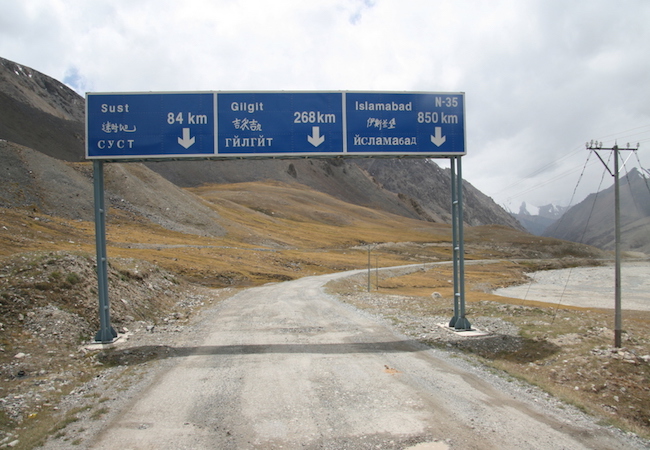
By Sadia Kazmi
China-Pakistan Economic Corridor (CPEC) is garnering greater attention around the world where more and more state leaders are expressing inclination to join the project. In a recent statement by Jammu and Kashmir Chief Minister Mehbooba Mufti, it has been suggested that both Indian held Kashmir and Azad Kashmir should be made part of the project in order to eventually create a trade corridor between South Asia and Central Asia. She also stressed that the traditional road links should be opened for the free movement of people and goods across the region. This would include Srinagar-Muzaffarabad, Poonch-Rawlakot, along with Suchetgarh-Sialkot, Kargil-Skardu, Bandipora-Gurez-Gilgit and Nowshera-Mirpur roads. This way, whole of the Kashmir can serve as a nucleus in this project. Even though the proposal sounds too lucrative not to be taken seriously; there are a number of caveats attached.
No doubt it gives hope of having regional cooperation, transit, trade, and energy transformation. The idea as opposed to the present realities is not a farfetched one. In the past the subcontinent was linked with Central Asia through Kashmir. Subcontinent would always be used as the transit route for trade purposes which was a constant source of peace, stability, and cross-cultural prosperity. However this opportunity was lost as a result of the partition in the year 1947.
Not only did it leave the newly created states Pakistan and India without a natural source for their energy and economic needs, but the partition also brought forth the issue Kashmir between the two. Since it became a disputed territory, the chances of accessing Central Asia through Kashmir remained quite unlikely. However in view of the changing geo-economic and geo-political scenarios at the regional and global levels, the ideas for reopening of traditional trans-Jammu and Kashmir and trans-Azad Kashmir routes, have been floated by Ms. Mufti.
There is a growing recognition that Kashmir having the potential to serve as a nucleus for CPEC project will reap immense economic benefit. It will not only help in the development of Kashmir itself but will lead to regional integration which will eventually foster the energy cooperation at the regional level, since the oil and gas rich resources of Central Asia could easily be accessed and made use of through such an arrangement. Hence this ideal geographical location of Kashmir should be utilized to the optimum level in developing a new economic alliance between the regions through it. If this materializes, it will be immensely supplementing the CPEC along with combining the two emerging economic hubs i.e. South and Central Asia. Kashmir itself will be able to have some political and economic stability.
However, talking about the caveats, the first and foremost is the India factor. There has been a repeated show of concern with regards to CPEC within the Indian official circles since the beginning of this project. Connecting CPEC to Central Asia through trans-Kashmir arrangement doesn’t sit well with India. It has been very vocal in stating that China is trying to violate India’s territorial sovereignty through CPEC, as it passes through Azad Kashmir, which India still believes to be its own territory.
Secondly, there is also an apprehension that if CPEC is allowed to pass through Azad Kashmir, which according to them is Pakistan Occupied Kashmir i.e. under Pakistan’s influence; this will give some kind of legitimacy to Pakistan’s control over Azad Kashmir. This of course is not acceptable to India at any cost as for India; the whole Kashmir belongs to them.
India also fears that through CPEC, China aims to meddle into the Kashmir dispute between India and Pakistan. China and Pakistan both will be able to put pressure on India to resolve the Kashmir dispute by either accepting independence for Azad Kashmir or lose it to Pakistan. None of the options sound tempting to India; hence its position on CPEC remains skeptical.
India is also staying watchful of China’s growing influence in the South Asian region. India being the geographically largest and economically better off state than other South Asian countries considers itself to be the natural regional power of South Asia and enjoys a relative edge over others. For India, it is a source of concern if China takes over South Asia through CPEC and topples India’s “hegemony” by toppling the regional status quo. India doesn’t only see itself as a regional power but have global aspirations. In this regard, it will always want to maintain its domination in the South Asian region.
However amidst all these ifs and buts, the materialization of trans-Kashmir route will generate around 1 million jobs and will bring in extensive Foreign Direct Investment (FDI) for the whole region. China has tried to mitigate India’s fear by openly stating that it is not planning to mediate between India and Pakistan over the Kashmir issue. It has always adviced to find a bilateral solution to this problem and plans to continue with the same approach. Chinese statements also advice India not to feel threatened by the development in Pakistan as it will not overshadow or compromise Chinese relations with India. In wake of all these assurances, India should take a more practical and less skeptical approach towards CPEC. It is the time when the whole world is looking at CPEC with the mixed reactions. They do want to join it but weighing their options and weighting for the right time to do that, depending upon the initial success of CPEC. India has a ripe opportunity to join in and reap early benefits instead of waiting till later for no reason. It is also to be kept in mind that China has invested a lot in this project and for China the success of CPEC is the most important concern hence the possibility of regional integration including the trans-Kashmir arrangement cannot be ruled out.




